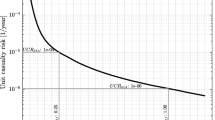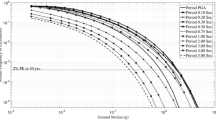Abstract
The assessment of historical elements at risk from earthquake loading presents a number of differences from the seismic evaluation of modern structures, for design or retrofitting purposes, which is covered by existing building codes, and for the development of fragility curves, procedures for which have been extensively developed in the past decade. This article briefly discusses: the hazard framework for historical assets, including a consideration of the appropriate return period to be used for such elements at risk; the intensity measures that could be used to describe earthquake shaking for the analysis of historical assets; and available approaches for their assessment. We then discuss various unique aspects of historical assets that mean the characterisation of earthquake loading must be different from that for modern structures. For example, historical buildings are often composed of heterogeneous materials (e.g., old masonry) and they are sometimes located where strong local site effects occur due to: steep topography (e.g., hilltops), basin effects or foundations built on the remains of previous structures. Standard seismic hazard assessment undertaken for modern structures and the majority of sites is generally not appropriate. Within the PERPETUATE project performance-based assessments, using nonlinear static and dynamic analyses for the evaluation of structural response of historical assets, were undertaken. The steps outlined in this article are important for input to these assessments.

Similar content being viewed by others
Notes
This article (and the PERPETUATE project) concerns historical buildings, such as those found in the centres of many towns in Europe, monuments (e.g., statues) and building contents (e.g., art works). In the following we use the general term ‘historical assets’ to mean all these types of elements at risk.
References
Abrahamson N, Atkinson G, Boore D, Bozorgnia Y, Campbell K, Chiou B, Idriss IM, Silva W, Youngs R (2008) Comparisons of the NGA ground-motion relations. Earthq Spectra 24(1):45–66
Anastasopoulos I, Gazetas G (2007) Foundation-structure systems over a rupturing normal fault: part I. Observations after the Kocaeli 1999 earthquake. Bull Earthq Eng 5(3):253–275
Anastasopoulos I, Gazetas G, Bransby MF, Davies MCR, El Nahas A (2009) Normal fault rupture interaction with strip foundations. J Geotech Geoenviron Eng, ASCE 135(3):359–370
Arias A (1970) A measure of earthquake intensity. In: Hansen RJ (ed) Seismic design for nuclear power plants. The M.I.T. Press, Cambridge, pp 438–483
Baturay MB, Stewart JP (2003) Uncertainty and bias in ground-motion estimates from ground response analyses. Bull Seismol Soc Am 93(5):2025–2042
Bazzurro P, Cornell CA (1999) Disaggregation of seismic hazard. Bull Seismol Soc Am 89(2):501–520
Bazzurro P, Cornell CA (2002) Vector-valued probabilistic seismic hazard analysis (VPSHA). In: Proceedings of 7th U.S. National Conference on Earthquake Engineering, Boston, MA, July 21–25, Paper No. 61
Bommer JJ, Martinez-Pereira A (1999) The effective duration of earthquake strong motion. J Earthq Eng 3(2):127–172
Chapman MC (1999) On the use of elastic input energy for seismic hazard analysis. Earthq Spectra 15(4):607–635
Delavaud E, Cotton F, Akkar S, Scherbaum F, Danciu L, Beauval C, Drouet S, Douglas J, Basili R, Sandikkaya MA, Segou M, Faccioli E, Theodoulidis N (2012) Toward a ground-motion logic tree for probabilistic seismic hazard assessment in Europe. J Seismol 16(3):451–473. doi:10.1007/s10950-012-9281-z
Douglas J (2010) Consistency of ground-motion predictions from the past four decades. Bull Earthq Eng 8(6):1515–1526. doi:10.1007/s10518-010-9195-5
Douglas J (2011) Ground-motion prediction equations 1964–2010, Final report, BRGM/RP-59356-FR (PEER 2011/102), 444 pages, 9 (illustrations)
Douglas J (2012) Consistency of ground-motion predictions from the past four decades: peak ground velocity and displacement, Arias intensity and relative significant duration. Bull Earthq Eng 10(5):1339–1356. doi:10.1007/s10518-012-9359-6
Douglas J, Aochi H (2008) A survey of techniques for predicting earthquake ground motions for engineering purposes. Surv Geophys 29(3):187–220. doi:10.1007/s10712-008-9046-y
Faccioli E, Anastasopoulos I, Callerio A, Gazetas G (2008) Fault rupture-foundation interaction: selected case histories. Bull Earthq Eng 6(4):557–583. doi:10.1007/s10518-008-9089-y
Fotopoulou S, Pitilakis K (2012) Vulnerability assessment of reinforced concrete buildings subjected to seismically triggered slow-moving earth slides. Landslides. doi:10.1007/s10346-012-0345-5
Fotopoulou S, Pitilakis K (2013) Fragility curves for reinforced concrete buildings to seismically triggered slow-moving slides. Soil Dyn Earthq Eng 48:143–161
Galli P, Galadini F (2001) Surface faulting of archeological relics. A review of case histories from the Dead Sea to the Alps. Tectonophysics 335(3):291–312
Gallipoli MR, Bianca M, Mucciarelli M, Parolai S, Picozzi M (2013) Topographic versus stratigraphic amplification: mismatch between code provisions and observations during the L’Aquila (Italy, 2009) sequence. Bull Earthq Eng 11(5):1325–1336. doi:10.1007/s10518-013-9446-3
Garini E, Gazetas G (2013) Damage potential of near-fault records: sliding displacement against conventional intensity measures. Bull Earthq Eng 11(2):455–480
Garini E, Gazetas G, Anastasopoulos I (2011) Asymmetric ‘Newmark’ sliding caused by motions containing severe ‘directivity’ and ‘fling’ pulses. Géotechnique 61(9):753–756
Gazetas G, Loli M, Anastasopoulos I (2014) Effects of permanent ground displacements due to near fault conditions on the seismic performance of masonry structures. Bull Earthq Eng (this issue)
Gazetas G (2012) Some presumptions on the nature of base excitation may erroneously affect the response of strongly inelastic systems. In: Proceedings of the 15th World Conference on Earthquake Engineering (WCEE), Lisbon, Portugal
Gazetas G, Garini E, Anastasopoulos I (2009) Effects of near-fault ground shaking on sliding systems. J Geotech Eng, ASCE 135(12):1906–1921
Gehl P, Seyedi DM, Douglas J (2013) Vector-valued fragility functions for seismic risk evaluation. Bull Earthq Eng 11(2):365–384. doi:10.1007/s10518-012-9402-7
Gelagoti F, Kourkoulis R, Anastasopoulos I, Gazetas G (2012) Nonlinear dimensional analysis of trapezoidal valleys subjected to vertically propagating SV waves. Bull Seismol Soc Am 102(3):199–1017
Gelagoti F, Kourkoulis R, Anastasopoulos I, Tazoh T, Gazetas G (2010) Seismic wave propagation in a very soft alluvial valley: sensitivity to ground motion“details” and soil nonlinearity, generation of parasitic vertical component. Bull Seismol Soc Am 100(6):3035–3054
Goda K, Atkinson GM (2009) Probabilistic characterization of spatially correlated response spectra for earthquakes in Japan. Bull Seismol Soc Am 99(5):3003–3020
Hancock J, Bommer JJ (2005) The effective number of cycles of earthquake ground motion. Earthq Eng Struct Dyn 34:637–664. doi:10.1002/eqe.437
Housner GW (1959) Behavior of structures during earthquakes. J Eng Mech Div, ASCE 85(EM14):109–129
Jayaram N, Baker JW (2009) Correlation model for spatially distributed ground motion intensities. Earthq Eng Struct Dyn 38(15):1687–1708
Karakhanian AS, Trifonov VG, Ivanova TP, Avagyan A, Rukieh M, Minini H, Dodonov AE, Bachmanov DM (2008) Seismic deformation in the St. Simeon Monasteries (Qal’at Sim’an), Northwestern Syria. Tectonophysics 453(1–4):122–147
Lagomarsino S, Cattari S (2014) PERPETUATE guidelines for seismic performance-based assessment of cultural heritage masonry structures. Bull Earthq Eng (this issue)
Lagomarsino S, Modaressi H, Pitilakis K, Bosjlikov V, Calderini C, D’Ayala D, Benouar D, Cattari S (2010) PERPETUATE Project: the proposal of a performance-based approach to earthquake protection of cultural heritage. Adv Mater Res 133–134:1119–1124
Lagomarsino S, Abbas N, Calderini C, Cattari S., Rossi M, Ginanni Corradini R, Marghella G, Mattolin F, Piovanello V (2011) Classification of cultural heritage assets and seismic damage variables for the identification of performance levels. In: Proceedings of structural repairs and maintenance of heritage architecture conference (STREMAH), WIT Press, pp. 697–708 ISSN 1743–3509
Loli M, Bransby MF, Anastasopoulos I, Gazetas G (2010) Interaction of caisson foundations with a seismically rupturing normal fault: centrifuge testing versus numerical simulation. Geotechnique 62(1):29–43
Miranda E, Bertero VV (1994) Evaluation of strength reduction factors for earthquake-resistant design. Earthq Spectra 10(2):357–379
Negulescu C, Foerster E (2010) Parametric studies and quantitative assessment of the vulnerability of a RC frame building exposed to differential settlements. Nat Hazards Earth Syst Sci 10(9):1781–1792. doi:10.5194/nhess-10-1781-2010
Oliveira CS (2003) Seismic vulnerability of historical constructions: a contribution. Bull Earthq Eng 1(1):37–82
Pace B, Albarello D, Boncio P, Dolce M, Galli P, Messina P, Peruzza L, Sabetta F, Sanò T, Visini F (2011) Predicted ground motion after the L’Aquila 2009 earthquake (Italy, \(\text{ M }_{{\rm w}}\) 6.3): input spectra for seismic microzoning. Bull Earthq Eng 9(1):199–230. doi: 10.1007/s10518-010-9238-y
Paolucci R, Smerzini C (2008) Earthquake-induced transient ground strains from dense seismic networks. Earthq Spectra 24(2):453–470. doi:10.1193/1.2923923
Pitilakis K (2004) In: Ansal A (eds) Site effects, recent advances in earthquake geotechnical engineering and microzonation. Springer, Netherlands
Pitilakis D, Clouteau D (2010) Equivalent linear substructure approximation of soil-foundation-structure interaction: model presentation and validation. Bull Earthq Eng 8(2):257–282. doi:10.1007/s10518-009-9128-3
Pitilakis D, Karatzetzou A (2014) Impedance functions of flexible foundations to assess soil-foundation-structure interaction in masonry monumental buildings. Bull Earthq Eng (this issue)
Pitilakis K, Riga E, Anastasiadis A (2012) Design spectra and amplification factors for Eurocode 8. Bull Earthq Eng 10(5):1377–1400. doi:10.1007/s10518-012-9367-6
Pitilakis K, Riga E, Anastasiadis A (2013a) New code site classification, amplification factors and normalized response spectra based on a worldwide ground-motion database. Bull Earthq Eng 11(4):925–966. doi:10.1007/s10518-013-9429-4
Pitilakis K, Riga E, Anastasiadis A (2013b) Erratum to: new code site classification, amplification factors and normalized response spectra based on a worldwide ground-motion database. Bull Earth Eng 11(4):967. doi:10.1007/s10518-013-9440-9
Pitilakis D, Moderessi-Farahmand-Razavi A, Clouteau D (2013c) Equivalent-linear dynamic impedance functions of surface foundations. J Geotech Geoenviron Eng 139(7):1130–1139. doi:10.1061/(ASCE)GT.1943-5606.0000829
Priestley MJN, Calvi GM, Kowalsky MJ (2007) Displacement-based seismic design of structures. IUSS Press, Pavia 721
Rathje EM, Faraj F, Russell S, Bray JD (2004) Empirical relationships for frequency content parameters of earthquake ground motions. Earthq Spectra 20(1):119–144
Seyedi DM, Gehl P, Douglas J, Davenne L, Mezher N, Ghavamian S (2010) Development of seismic fragility surfaces for reinforced concrete buildings by means of nonlinear time-history analysis. Earthq Eng Struct Dyn 39:91–108. doi:10.1002/eqe.939
Toh JCW, Pender MJ (2008) Earthquake performance and permanent displacements of shallow foundations. In: Proceedings of New Zealand Society for Earthquake Engineering Conference, paper number 40
Acknowledgments
The work presented in this article has been funded by the PERPETUATE (Performance-based approach to earthquake protection of cultural heritage in European and Mediterranean countries) project of the EC-Research Framework Programme FP7. We thank two anonymous reviewers and the guest editors Sergio Lagomarsino and Dina D’Ayala for their comments on a previous version of this article.
Author information
Authors and Affiliations
Corresponding author
Additional information
Darius M. Seyedi, Hormoz Modaressi and Evelyne Foerster Formerly at: BRGM, Orléans, France.
Rights and permissions
About this article
Cite this article
Douglas, J., Seyedi, D.M., Ulrich, T. et al. Evaluation of seismic hazard for the assessment of historical elements at risk: description of input and selection of intensity measures. Bull Earthquake Eng 13, 49–65 (2015). https://doi.org/10.1007/s10518-014-9606-0
Received:
Accepted:
Published:
Issue Date:
DOI: https://doi.org/10.1007/s10518-014-9606-0




